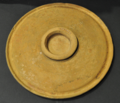MI·14
| Inscription | |
|---|---|
| Reading in transliteration: | ?i?mi |
| Reading in original script: | ? |
|
| |
| Object: | MI·14 Parabiago (plate) |
| Position: | bottom, outside |
| Orientation: | 90° |
| Direction of writing: | ambiguous |
| Script: | unknown |
| Letter height: | 0.9 cm–1.6 0.354 in <br />1.6 cm <br />0.63 in <br /> |
| Number of letters: | 5 |
| Number of words: | 1 |
| Number of lines: | 1 |
| Workmanship: | scratched after firing |
| Condition: | complete, damaged |
|
| |
| Archaeological culture: | Augustan [from object] |
| Date of inscription: | late 1st c. BC [from object] |
|
| |
| Type: | unknown |
| Language: | unknown |
| Meaning: | unknown |
|
| |
| Alternative sigla: | Morandi 2004: 281 |
|
| |
| Sources: | Morandi 2004: 708 f. no. 281 |
Images
Commentary
First published in Morandi 2004: 708 f., no. 281. Examined for LexLep on 25th January 2022.
Images in Volonté 1996: 45, tav. 5.1 (drawing), Morandi 2004: 708 f. (photo).
Inscribed at an angle of 90° on the bottom of the plate, either from the rim of the foot upward or toward it (length 4.2 cm). Morandi, who saw the worn inscription in 2002, reads it in the opposite orientation and writing direction as it is displayed in Volonté 1996, and gives the tentative reading ai?mi. He does not offer an interpretation beyond the suggestion that -i could be the genitive ending of a personal name, i.e. an owner's inscription, and notes that the script may be Latin.
The reading is impeded both by the heavy abrasion of the surface and the modern tracing of the letters with white chalk. On the side farthest from the rim, iota and mu seem plausible. Of the middle letter (?), only a small triangle and possibly part of a hasta on the right are distinguishable; then possibly another iota. The group of scratches nearest the rim, interpreted as a rather artistically drawn dextroverse alpha by Morandi, is difficult to consolidate into a letter (or two). Below it, what looks like sinistroverse pi ![]() is visible comparatively clearly. Additional faint traces of possibly intentional scratches can be seen ca. 3.5 cm and again at ca. 12 cm to the left of the inscription. All in all, orientation and direction, script and reading must all be considered highly uncertain.
is visible comparatively clearly. Additional faint traces of possibly intentional scratches can be seen ca. 3.5 cm and again at ca. 12 cm to the left of the inscription. All in all, orientation and direction, script and reading must all be considered highly uncertain.


